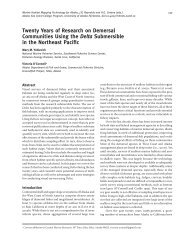724_Final Report.pdf - North Pacific Research Board
724_Final Report.pdf - North Pacific Research Board
724_Final Report.pdf - North Pacific Research Board
Create successful ePaper yourself
Turn your PDF publications into a flip-book with our unique Google optimized e-Paper software.
appropriate for estimating a consumer diet that is more heavily influenced by carbohydrates. Additionally,<br />
we speculate that differences in CCs may also be due to differences in age classes (adults versus chicks).<br />
That is, growing chicks may differentially use or mobilize essential and other FAs for tissue growth. To<br />
our knowledge, this is the first study to calculate CCs for adult birds from adipose tissue. For future<br />
research, we suggest a captive validation study on eider ducklings to determine the effect of age class<br />
(adult versus ducklings) on CCs.<br />
We have demonstrated that QFASA can be a powerful technique for estimating diets of captive<br />
eiders, potentially providing a minimally invasive method for obtaining information about their diets in<br />
the wild. The issues and requirements for using QFASA and assembling a prey library have previously<br />
been reviewed (Iverson et al. 2004, 2007, Budge et al. 2006, Iverson 2009). In regards to marine birds,<br />
there remain several areas for further investigation. The development of species-specific CCs is a<br />
necessary component of QFASA. We are aware of only two other studies that have calculated CCs for<br />
marine birds: common murre chicks (Iverson et al. 2007) and tufted puffin chicks Fratercula cirrhata<br />
(Williams et al. 2009). The common murre chicks were fed a diet composed entirely of Atlantic<br />
silversides for 45 days. The tufted puffin chicks were fed <strong>Pacific</strong> herring Clupea pallasi in two groups for<br />
27 days: high calorie (120 g herring/day) and low calorie (restricted to 60 g herring/day) and the CCs of<br />
low and high-calorie diets were highly correlated (Williams et al. 2009). In this captive study, although<br />
the diet was only strictly regulated for 69 days prior to the biopsy for CCs, the eiders had been on a<br />
similar diet for over 3 years (consisting of almost entirely Mazuri, but with additional supplements that<br />
we incorporated into our calculations). Thus, we assumed the eiders’ FA signatures would look as much<br />
like the diet as it ever would, and used this as a basis for weighting FAs. Because of the length of time of<br />
the long-term diet, we are confident we have good estimates for CCs for the eiders used in the<br />
experiment. However, given the differences between the eider and common murre chick CCs, and the<br />
differences in model estimates using different CCs and FA subsets, more controlled studies are needed to<br />
22



